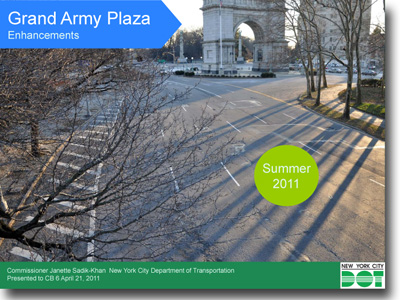
Coming this summer to Grand Army Plaza: safer driving, easier pedestrian crossings, and more cycling connections, thanks to improvements from the city’s Department of Transportation.
Representatives from the agency presented these changes and a construction schedule at the Grand Army Plaza Coalition’s annual meeting, held on April 16 at 1 Grand Army Plaza. “GAPCo is a forum for stakeholders in the area to discuss issues of concern in the city’s premier public plaza,” said chair Rob Witherwax. The alliance brings together cultural organizations, residents around the space, community boards, block associations, and elected officials, including the Park Slope Civic Council, a founding member.
One of the biggest changes will be a new traffic signal and barrier on the west side of the plaza. This setup will remove a now-dangerous traffic merge of vehicles heading south on Flatbush and Vanderbilt Avenues with those driving around the circle to meet Union Street and Prospect Park West.
The DOT’s plans also include new signals, traffic islands, and crosswalks at the plaza’s northern end, where Flatbush and Vanderbilt meet. On the south end, site of the greenmarket every Saturday, gravel treatment and granite blocks will improve this much-used space and more clearly separate it from the adjacent roadway. A similar treatment will also be added to the area between the arch and the steps to the Bailey Fountain in the plaza’s center.
Protected bike lanes will be installed coming off Union Street, which will help fill in gaps in the current cycling network.
Construction work will begin nights in June at various points in the plaza. Major work, some of which will have to take place in the daytime, will stretch from Independence Day to Labor Day. The only traffic diversion will be a small one at the north end in July, said DOT design coordinator Terra Ishee, to allow for construction of the traffic barrier.
The plan DOT put forth was very similar to one presented in 2010 (see the May 2010 issue of Civic News), but with modifications suggested by the community, said Chris Hrones, the DOT’s Downtown Brooklyn construction coordinator. “DOT has been excellent about coming to the community, discussing its ideas, and getting proper signoffs,” Witherwax added.
The biggest change from last year’s concept is that DOT will not be moving ahead with a separated bike-lane upgrade for Plaza Street, said Josh Benson, director of bicycle and pedestrian programs, “due to concerns from the community that DOT will address.” Witherwax expects GAPCo to do more community outreach and get more ideas on this aspect of the project.
The new DOT plan will be presented to Community Boards 6 and 8 over the next few weeks for their approval.
Another improvement will be the return of a former Grand Army Plaza resident. The monument to Abraham Lincoln, which decades ago had been moved to Prospect Park’s Concert Grove and wound up facing the back of Wollman Rink, will be returned the plaza sometime over the next 12 months. The move, said Eric Landau of the Prospect Park Alliance’s government relations office, is part of the construction of Lakeside Center, the rink’s replacement. The statue, he noted, will be at the very northern end of the plaza, directly across the street from the John F. Kennedy memorial, “so we will have a ‘conversation’ between the two leaders.”
Also at the meeting, the local cultural partnership Heart of Brooklyn announced plans to develop a wayfinding system in and around Grand Army Plaza. “We want to improve movement of people between institutions and around the community,” said Ellen Salpeter, Heart of Brooklyn’s director. Requests for proposals for the signage system will be going out soon; the goal is to have the system in place by fall 2012.
— David Herman
from the Spring 2011 Civic News

